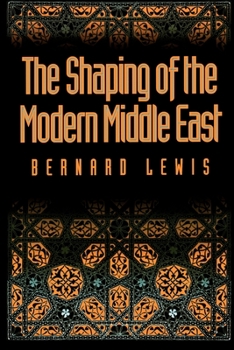The Shaping of the Modern Middle East
Select Format
Select Condition 
Book Overview
With this major revision of his classic The Middle East and the West (1964), a leading Middle East historian of our time offers a definitive and now more-timely-than-ever history of Western-Middle Eastern relations from the late seventeenth century to the present day. Fully revised to cover the volatile developments of the last three decades, The Shaping of the Modern Middle East sheds light on the climax and sudden end of the cold war, the disintegration...
Format:Paperback
Language:English
ISBN:0195072820
ISBN13:9780195072822
Release Date:February 1994
Publisher:Oxford University Press, USA
Length:200 Pages
Weight:0.75 lbs.
Dimensions:0.5" x 6.2" x 9.3"
Customer Reviews
3 ratings
A valuable work
Published by Thriftbooks.com User , 22 years ago
Thirty years after publish his seminal "Middle East and the West" Lewis here updates it to take into account a number of dramatic changes in the region. Bernard Lewis may well be the greatest living scholar of Arab and Muslim culture. His understanding and respect for the people and history in the region makes it possible for him to strike a rare balance between those who believe Arab culture can do no wrong and those who believe it can do no right.Lewis' original work was based on the thesis that the Middle East had not come to terms with the West, culturally or politically. When he wrote this updated work in 1994, after the fall of the Soviet Union, considerable reason for hope existed that pervasive globalization would integrate the Middle East into the rest of the world.Sadly, he may have written too early. Recent event indicate that the traditional Islamic hostility to the west are striking back with a vengeance. Moreover, it is unclear whether any of the modernizing nation states in the region have the legitimacy with their own people to survive the coming assault.While events have made this work somewhat dated, it is still offers essential perspective to understanding Islam, the Arab world, and the possible future. For those with a serious interest, it is a must read.
The Shaping of the Modern Middle East
Published by Thriftbooks.com User , 22 years ago
Thirty years after the publication of The Middle East and the West, Lewis has reissued that excellent study in a slightly updated and enlarged form. The changes are pervasive but not deep; while figures like the Ayatollah Khomeini do appear in its pages, such issues of the 1960s as Arab socialism and Soviet-Egyptian relations remain at the heart of the study. This said, the 1964 version concludes with the observation that "Friendship will be possible only when Arab nationalism is prepared to come to terms with the West." That having more or less taken place, the 1994 version ends by noting that "for the first time in centuries, the course of events in the Middle East is being shaped not by outside but by regional powers. The choice, at last, is their own." To sum up, while the new first page is identical in substance with the old one, the last pages in the two versions differ completely one from the other. "Shaping of the Modern Middle East" has many enduring virtues of which two stand out. It presents with succinct clarity nearly all the great intellectual themes that influenced Middle Eastern life over the past two centuries. And it presents a vision of the Middle East as a whole, with Iran and Turkey no less important than the Arabic-speaking countries, a perspective which causes the Arab-Israeli conflict to shrink to its true proportions.) In short, Shaping of the Modern Middle East remains perhaps the best single volume for learning about the vast subject matter it covers. Middle East Quarterly, December 1994
The Shaping of the Modern Middle East
Published by Thriftbooks.com User , 22 years ago
Thirty years after the publication of The Middle East and the West, Lewis has reissued that excellent study in a slightly updated and enlarged form. The changes are pervasive but not deep; while figures like the Ayatollah Khomeini do appear in its pages, such issues of the 1960s as Arab socialism and Soviet-Egyptian relations remain at the heart of the study. This said, the 1964 version concludes with the observation that "Friendship will be possible only when Arab nationalism is prepared to come to terms with the West." That having more or less taken place, the 1994 version ends by noting that "for the first time in centuries, the course of events in the Middle East is being shaped not by outside but by regional powers. The choice, at last, is their own." To sum up, while the new first page is identical in substance with the old one, the last pages in the two versions differ completely one from the other. "Shaping of the Modern Middle East" has many enduring virtues of which two stand out. It presents with succinct clarity nearly all the great intellectual themes that influenced Middle Eastern life over the past two centuries. And it presents a vision of the Middle East as a whole, with Iran and Turkey no less important than the Arabic-speaking countries, a perspective which causes the Arab-Israeli conflict to shrink to its true proportions.) In short, Shaping of the Modern Middle East remains perhaps the best single volume for learning about the vast subject matter it covers....





